Standard [CURRENT]
ASTM F 2477:2024
Standard Test Methods for in vitro Pulsatile Durability Testing of Vascular Stents and Endovascular Prostheses
- Publication date
- 2024
- Original language
- English
- Pages
- 14
- Publication date
- 2024
- Original language
- English
- Pages
- 14
- DOI
- https://dx.doi.org/10.1520/F2477-24
Product information on this site:
Quick delivery via download or delivery service
Buy securely with a credit card or pay upon receipt of invoice
All transactions are encrypted
Short description
1.1 These test methods cover the determination of the durability of a vascular stent or endoprosthesis by exposing it to diametric deformation by means of hydrodynamic pulsatile loading. This testing occurs on a test sample that has been deployed into a mock (elastically simulated) vessel. The test is conducted for a number of cycles to adequately establish the intended fatigue resistance of the sample. 1.2 These test methods are applicable to balloon-expandable and self-expanding stents fabricated from metals and metal alloys and endovascular prostheses with metal stents. This standard does not specifically address any attributes unique to coated stents, polymeric stents, or biodegradable stents, although the application of this test method to those products is not precluded. 1.3 These test methods may be used for assessing stent and endovascular prosthesis durability when exposed to blood vessel cyclic diametric change. These test methods do not address other cyclic loading modes such as bending, torsion, extension, or compression. 1.4 These test methods are primarily intended for use with physiologically relevant diametric change, however guidance is provided for hyper-physiologic diametric deformation (that is, fatigue to fracture). 1.5 These test methods do address test conditions for curved mock vessels, however might not address all concerns. 1.6 The values stated in SI units are to be regarded as standard. No other units of measurement are included in this standard. 1.7 This standard does not purport to address all of the safety concerns, if any, associated with its use. It is the responsibility of the user of this standard to establish appropriate safety, health, and environmental practices and determine the applicability of regulatory limitations prior to use. 1.8 This international standard was developed in accordance with internationally recognized principles on standardization established in the Decision on Principles for the Development of International Standards, Guides and Recommendations issued by the World Trade Organization Technical Barriers to Trade (TBT) Committee.
ICS
11.040.25
DOI
https://dx.doi.org/10.1520/F2477-24
Also available in
Loading recommended items...
Loading recommended items...
Loading recommended items...
Loading recommended items...

